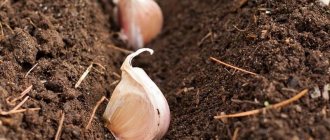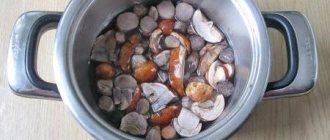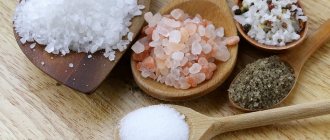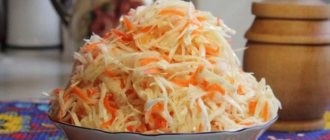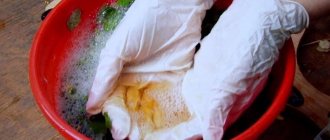Where do different opinions come from?
The fact is that Peking cabbage, like white cabbage, is multi-layered, and the outer leaves protect the inner ones. Therefore, it seems logical to simply tear off the outer coverings. However, if you look carefully, Peking leaves have very curly leaves, and they do not fit tightly to each other - this means that at least the top of the vegetable is freely overgrown with dust during ripening.
From here it follows: you need to wash it thoroughly under running water or by lowering the entire head of cabbage into a basin. This decision categorically did not suit the cooks.
Judge for yourself: if you pour plenty of water into many folds and loosely pressed leaves. Will all the water then be able to drain? No. A noticeable amount of it will go into the dish. That's why Miss Clean magazine doesn't recommend washing whole bok choy for salad.
Important You cannot wash the entire head of cabbage if part of it remains for storage: water in the folds provokes rotting of the vegetable, it goes rotten and becomes a haven for bacteria.
Outputs and solutions
The housewife found two solutions:
- If you don’t trust a clean vegetable, you need to take it apart into leaves and wash each one separately or two at a time and put it on a towel to dry it off.
- Wash by spreading the crown well and using boiled water. Then turn the head of cabbage upside down and lightly tap with your palm to shake out the moisture without causing splashes.
The first method is especially convenient if you take Chinese cabbage in parts for a salad: the leaves are washed for cooking, and the main head is sent back to the “fresh zone” section.
Tip Any vegetables, including bok choy, are best kept fresh in a glass container with a lid.
Before cooking, if the cabbage is gone entirely, wash it however you like, even just under the tap. When cooking or stewing, a few drops of raw water will mix with what is already poured into the pan and will not play a role. If the cabbage is going to be fried or baked, then you should wash the leaves one at a time and dry them - otherwise the vegetable will stew.
Cooks advise removing the top leaves and stalks, like those of cabbage, as the main layer of dust and pesticides settles on them.
Beijing or Chinese cabbage is soft in taste, crispy and juicy, and also looks impressive in a salad. Pour boiling water over or rinse under the tap only that part of the head of cabbage that you will definitely use in cooking. Wrap the rest in parchment so that it breathes but does not lose moisture. And then you can safely enjoy this delicious vegetable for more than one day.
Contrary to various disputes, it is necessary to wash Chinese cabbage before eating - but you need to know how and when.
Which cabbage to choose for sourdough and whether it needs to be washed
The final result largely depends on the correct choice of vegetable. Therefore, before we learn all the intricacies of preparing white cabbage for pickling, let’s talk about how to choose the right head of cabbage.
- We choose fruit exclusively from late varieties.
- The weight of the head of cabbage must be at least 1 kg, and the shape must be round and slightly flattened at the ends.
- You should try purchased cabbage in advance, even before slicing: if it has a pleasant sweetish flavor, then such cabbage is ideal. If the fork has a bitter taste, even a mild one, refuse to ferment such a vegetable.
- Also, do not ferment cabbage if it is dry. Please note that such a vegetable will not release juice, and “causing” it with brine is useless, because the taste of such cabbage will be much inferior to cabbage fermented in its own juice.
Is cabbage washed before cooking (pickling and pickling)
For those who are planning to ferment fresh cabbage at home, the answer to the question will be interesting: do the heads of cabbage need to be washed?
If the heads of cabbage are too dirty, and pieces of dust and dirt are found even under the top sheets, then you can rinse the vegetables, but then be sure to wipe them dry so that no drops of water remain. We don't want water to dilute the natural cabbage juice.
As for washing already chopped cabbage, everything is clear and obvious here - you absolutely cannot wash the vegetable in this form, otherwise it will turn out watery, which will prevent fermentation under natural conditions, i.e. in its pure natural juice.
Where do different opinions come from?
The fact is that Peking cabbage, like white cabbage, is multi-layered, and the outer leaves protect the inner ones. Therefore, it seems logical to simply tear off the outer coverings. However, if you look carefully, Peking leaves have very curly leaves, and they do not fit tightly to each other - this means that at least the top of the vegetable is freely overgrown with dust during ripening.
From here it follows: you need to wash it thoroughly under running water or by lowering the entire head of cabbage into a basin. This decision categorically did not suit the cooks.
Judge for yourself: if you pour plenty of water into many folds and loosely pressed leaves. Will all the water then be able to drain? No. A noticeable amount of it will go into the dish. That's why Miss Clean magazine doesn't recommend washing whole bok choy for salad.
Important You cannot wash the entire head of cabbage if part of it remains for storage: water in the folds provokes rotting of the vegetable, it goes rotten and becomes a haven for bacteria.
Do you need to wash Chinese cabbage?
Chinese cabbage is a cross between regular cabbage and lettuce. It’s not as tough as regular white cabbage, but it’s also not as “falling apart” as lettuce. Therefore, it is very good for preparing salads and other dishes.
When fresh, it is perfectly chewable and absorbed by the body, has a delicious soft taste and is full of a variety of useful microelements. But is it possible to grow it in our garden beds, since Beijing is far away and located in the tropical zone?
Freezing cauliflower at home
You can pickle Beijing kaputa very quickly and easily. This recipe is ideal for those who have no marinating experience. Despite the simplicity of preparation, the preparation has an excellent taste.
Required Products:
- 0.5 kg of Chinese cabbage;
- 50 gr. sea salt;
- 45 gr. Sahara;
- 100 ml fruit vinegar;
- 5 gr. peppercorns;
- 0.5 liters of purified water.
Preparation progress:
- Chinese cabbage is cut into thin strips.
- Water is poured into the pan and then sugar, vinegar and salt are added to it, then boiled.
- Place pepper and chopped cabbage in jars.
- Fill them with still boiling marinade.
- They are immediately corked, turned over and covered.
- Once cooled, they are transferred to the basement.
How to defrost cauliflower
For complementary feeding, the baby should be placed in a double boiler without preliminary defrosting and set to the required mode. It is very easy and simple to make various purees in this way by adding not only cabbage, but also other vegetables. You can also defrost in the microwave for 30 seconds in a special heating container.
If you are worried that it will lose all its beneficial properties or you are against such ovens, you can leave it to defrost at room temperature, but it will take more time. Choose any method convenient for you based on the availability of free time.
Do you need to wash Chinese cabbage?
Opinions differ on this matter. Many people believe that it is enough to remove the top sheets from the fork and you can start cooking. In fact, it definitely needs to be washed, and thoroughly. After the top sheets are removed, it is necessary to cut off the stalk and disassemble the forks into separate sheets, rinse each of them and pour boiling water over them.
In the same case, if damage or insects were found on the leaves, the cabbage must be subjected to additional processing. It should be placed in water, salted and left for 15 minutes. Salt water will help you get rid of all pests easily. After this, the sheets can already be chopped and made into all kinds of preparations or fresh salads.
Selection and preparation of cabbage for storage
To ensure that cabbage can be stored for a long time, preference is given to high-quality heads of cabbage with unrotted leaves that are not damaged by slugs and insects. Before being sent for long-term storage, all copies are carefully inspected and sorted.
The varieties that are characterized by the best taste properties are used as food first.
Suitable varieties
Only late-ripening varieties and some mid-season varieties are suitable for winter harvesting of vegetables . Their leaves are dense and elastic, while those of the early Peking plant are tender and soft. During the process of fermentation, pickling or freezing, such heads of cabbage will become tasteless, and the greens will turn into a mushy mass.
Reference. Small ones are left for processing or consumption, and large varieties are chosen for long-term storage. They are more resistant to frost, sudden temperature changes and are less susceptible to rotting.
The most suitable varieties of Chinese cabbage are those collected in Russian regions, preferably in the middle zone or southern latitudes. Heads of cabbage imported from Asian territories and imported hybrids are not suitable for winter harvesting. Such vegetables do not have sufficient shelf life and resistance to rotting.
The following varieties keep well:
Source: https://DSad12.ru/ovoshchi/nado-li-myt-kapustu-2.html
Features of Chinese cabbage
In fact, the location of Beijing has nothing to do with it, except that this culture comes from central China. But this does not in any way affect its cultivation in other countries, including Russia.
The plant is biennial, cold-resistant, the growing season is on average about 2 months, which makes it possible to grow not one, but two or three crops of this crop in a year.
The consistency of the head of cabbage is loose. The head of cabbage itself can have either a round or elongated shape, depending on the type of crop.
Widely used by gardeners to compact tomato, cucumber, squash and other beds.
How to store it correctly
Summer residents who have learned to cultivate this crop agree that even such tender heads of cabbage can be stored for 3–4 months without much damage or loss of quality.
It is necessary to follow these simple rules for preparing for storage:
- the forks must be well dried from excess moisture;
- the harvest is sorted, spoiled, frozen and old fruits are discarded;
- there is no need to be zealous about tearing off leaves with rotten spots, since the fork should be in its “clothing” - such vegetables are used for food first.
Should be stored in a cool, dry place away from bright light. A closet on a balcony, an underground floor, or a ventilated basement would work well. It’s a good idea to wrap each head of cabbage in paper so that excess moisture is absorbed. You can also put cling film tightly on top of the paper or without it.
Growing techniques
Although this crop is famous for its unpretentiousness, for proper and effective cultivation you should familiarize yourself with the main nuances and tricks associated with this crop. And first of all, it’s worth thinking about what is the best way to start growing, through seedlings, or by planting seeds in open ground?
Growing by seedlings is more suitable for Siberia and the Urals, but it is worth noting that excessive lighting can have a detrimental effect on the setting of heads of cabbage. Therefore, in conditions of long daylight hours, the plant will have to be manually shaded from the light, thereby shortening the excessively long daylight hours for these areas. Growing seedlings in general occurs in the same way as for white cabbage.
Basic parameters for planting Chinese cabbage in greenhouses:
- Planting in greenhouses using the seed sowing method can be carried out from March, then at the beginning of April, at the end of July and in mid-August. The seed planting pattern is 20 cm in a bed and 40 cm between beds. In other time periods, it is practiced to plant only universal hybrid varieties, namely “Chinese Selected”, “Naina F1”, “Lyubashi”, etc.
- It is also recommended to plant seedlings during the same time periods as in the case of seed sowing, with the only difference being that in this case the crop will ripen much faster. When planting seedlings in the ground, you should adhere to the scheme of 30 cm between plants in the bed and 50 between the beds.
Crop care
Like other crops, caring for Chinese cabbage is based on timely watering, feeding and weeding. To prevent plants from being affected by various types of rot, certain conditions should be created for the plant, consisting of a strict balance of ambient temperature and air humidity. These parameters should range within:
- daytime air temperature – 15 – 19°C, nighttime 8°C and above;
- air humidity on a cloudy day is 70%, on a sunny day – 80%, at night – 80%.
The soil moisture content should also be within 65%.
The soil should be rich in nitrogen and calcium. If these substances are not enough, you can fertilize with any mineral supplements that contain them; this will be enough to ripen a full and rich harvest. Also, if necessary, you can fertilize the soil with mullein.
In the fall, the soil should be fertilized by adding manure at the rate of 4.5 kg per square meter of potential beds, a tablespoon of superphosphate and 2 tablespoons of potassium sulfate also per square meter of land. Potassium sulfate can be replaced with wood ash - a liter jar of ash for each square meter of sown area.
Beijing cabbage Asten
In the spring, before planting, the soil is spilled from a watering can with a solution of bird droppings (half a kilo of droppings in a bucket of water), and enriching the soil with a tincture of chicken shells (crushing 30 g of shell and infusing it for 2 days in 5 liters of water) will also have a good effect on the crop. If the soil was not fertilized in the fall, it is also worth adding superphosphate, potassium sulfate and ammonium nitrate to the soil of future beds before planting. Each substance is added at the rate of 1 tablespoon per square meter of potential bed.
During drought, watering must be done daily, preferably using a watering can. Do not forget that although Chinese cabbage is moisture-loving, stagnant moisture can cause the crop to rot and be affected by various types of diseases.
Do I need to wash cabbage before pickling - AgroFlora.ru
To preserve all the beneficial properties of the cabbage harvest, housewives resort to pickling cabbage heads with and without the addition of various ingredients.
Many people are interested in whether it is necessary to wash cabbage before pickling, whether washing will harm the product, whether it will disrupt the process, and whether the cabbage will become watery. Let's consider the intricacies of properly salting heads of cabbage for the winter to obtain a crispy vitamin preparation, including the advisability of washing them.
Preparing cabbage for pickling, to wash or not to wash
Why ferment cabbage
When fermented, cabbage not only does not lose vitamins and beneficial microelements, but, on the contrary, is enriched with them to an even greater extent. The crunchy snack gets even more vitamin C: 100 g of the finished product contains about 70 mg of ascorbic acid, while ordinary fresh cabbage contains only 40 mg! The same applies to vitamin P: its amount in sauerkraut increases 20 times!
Heads of cabbage that have been fermented are similar in their effects to fermented milk products: they have the same beneficial effect on the body. The same applies to brine: it contains components that prevent the conversion of carbohydrates into fats. Sauerkraut is a real godsend for those who want to lose weight and get healthier.
Should I wash cabbage before pickling?
Many people are interested in whether cabbage is washed before pickling (fermentation). If we are talking about heads of cabbage, then yes, they can be washed with water after the top leaves are removed. This is necessary to wash away the smallest impurities that do not contribute to good fermentation.
If the question is whether it is necessary to wash shredded cabbage before subsequent salting, the answer is obvious: it is impossible. The fact is that cabbage, juicy on its own, will pick up excess moisture, which will dilute the cabbage juice and prevent normal fermentation and storage of the finished product. Moreover, it can turn out bitter and watery.
Do I need to wash cabbage before pickling?
How to prepare cabbage for pickling
- We take heads of mid-late or late cabbage: they are tight and juicy, rich in sugars necessary for high-quality fermentation.
- When salting cabbage with carrots, take carrots at the rate of 300 grams per 10 kilograms of cabbage. You can flavor the product with bay leaves, beets, caraway seeds, apples or lingonberries: the amount of additives is taken to taste.
- For fermentation you will need simple coarse salt without adding iodine - approximately 250 grams per 10 kg of raw materials.
- We clean the heads of cabbage from stalks and top leaves, as well as frostbitten, rotten and damaged by insects.
- If desired, rinse them with water and dry with paper towels.
- Peel other ingredients, if used: carrots, beets, apples.
In addition to the raw materials, we prepare a vessel where we will ferment the cabbage, for which it is better to use an enamel tank, and cover the bottom with clean and healthy cabbage leaves.
Having found out whether it is necessary to wash white cabbage before the fermentation process, we will find out how to properly ferment it with the addition of beets.
How to ferment cabbage with spices
Ingredients
- Medium cabbage – 4 pcs.
- Medium carrots – 8 pcs.
- Garlic cloves – 10 pcs.
- Coarse salt – 6 tbsp.
- Black peppercorns – 5 tsp.
- Bay leaf – 7 pcs.
- Warm water – 1 glass.
Is cabbage washed before pickling?
Cooking process
We have already found out whether it is necessary to wash shredded cabbage before pickling; all that remains is to follow the fermentation technology. Let's ferment cabbage as follows:
- We wash the cabbage before salting and move on.
- Grind the prepared vegetables: three carrots on a coarse grater, crush the peeled garlic, chop the cabbage.
- Sprinkle some of the chopped cabbage and carrot mixture with garlic with salt and mash with your hands until the juice appears.
- Transfer to an enamel tank and tamp.
- We repeat the same with the remaining portions of cutting.
- When everything is laid, add spices and tamp again.
- Pour water on top, place a wooden circle or dish + pressure.
- Cover the tank with a clean natural cloth or gauze and leave it in room conditions for three days.
The brine will be released on the second day. If foam appears, be sure to remove it so that the cabbage does not become bitter. For the same purpose, twice a day we pierce the cabbage mass with a wooden stick to the very bottom of the tank.
After settling the product, remove the oppression and the top layer of the darkened product. Transfer the cabbage into jars and cover with plastic lids.
Some housewives are interested in whether cabbage is washed before pickling, while others are interested in whether it is necessary to wash sauerkraut before eating. Definitely not necessary: why wash away the healthy brine, which helps improve metabolism and enrich the body with vitamins? Moreover, the product, which has a beautiful amber-yellow color, will become faded and less appetizing.
Having found out whether cabbage needs to be washed before pickling, let’s summarize: the raw material cannot be washed either before or after cooking. Sauerkraut should be stored at 0-5 degrees, in a dry place. If desired, you can freeze it: it will not lose its beneficial properties and will remain just as tasty.
Pests and methods of controlling them
Basically, Chinese cabbage can suffer from pests already known to every gardener. In particular, they are:
- cruciferous flea beetles;
- cabbage butterflies;
- slugs and snails;
- cruciferous bugs
Since cabbage can absorb harmful substances, it is best to use traditional methods to control pests. You can protect against pests by:
- planting Chinese cabbage between the rows of tomatoes, garlic or onions will also help by spraying the crop with a garlic-nightshade solution, for the preparation of which you need to take 200 g of potato tops, 200 g of tomato tops, 2 heads of garlic, chop all the ingredients and leave in a bucket of water for a day;
- constantly ridding cabbage beds of weeds;
- When cabbage butterflies appear, it is worth examining the lower parts of cabbage leaves for egg laying. This, although quite labor-intensive, method will help prevent the appearance of caterpillars and keep the crop intact.
Adviсe
You can increase the wintering duration of cabbage by following some rules:
- there is no need to leave the vegetable in a sealed bag, it needs good ventilation;
- The storage area should not be illuminated or exposed to direct sunlight;
- maintain a certain level of temperature and humidity in the room where the cabbage is located;
- periodically check the leaves for defects and rot;
- exclude the proximity of bananas and apples;
- Before packing into a storage container, the cabbage must be dried;
- When the first signs of wilting appear, it is recommended to consume the product.
Having learned about ways to store such a healthy vegetable, you can prepare dishes with its addition not only in the warm season of the year. Follow all storage rules, which will help the cabbage retain its freshness and taste for many months to come.
Add a comment Cancel reply
You must be logged in to post a comment.
Peking cabbage is a low-calorie product (only 16 kcal per 100 g) - you can eat almost kilograms and still lose weight. The vegetable contains a large amount of vitamins and coarse fibers that stimulate digestion, nourish the intestinal microflora and remove toxic substances from the body.
To retain all the benefits, it is important to properly prepare Chinese cabbage for cooking. We'll talk about this below. And “With Taste” has selected 5 proven recipes for salads and appetizers with this wonderful vegetable!
Other interesting questions and answers
What's the best way to prepare for anal sex?
If this is the first time (and maybe it will suit someone for subsequent times), then I would advise cleaning the intestines in an hour or two. But not with a liter enema, but do this:
1. Give an enema no more than 200 ml. 2. Be patient for 5-10 minutes 3. Empty your bowels Repeat one more time and give an enema with a chamomile solution, 100 ml somewhere. Just be sure to lubricate the tip with Vaseline or lubricant, otherwise your butt may hurt later and there will be no time for sex. And the main thing is not to overdo it, if you feel that even 100 ml is too much for you, then stop. This may seem disgusting to some, but it will help avoid any unpleasant moments. There is nothing disgusting about this, and those who say that there is no need to do an enema anymore are, apparently, terribly lucky. I was unlucky once and I don’t even want to remember.
Plus, the important thing before anal sex is not to be nervous and relax as much as possible.
Hello! You once talked about “muk” in the “Korean cuisine and dishes” section. Please share the recipe for making it... I tried it once, it is very tasty. I want to learn how to do it.
Should I wash cabbage before cooking?
Or is it enough to remove the top couple of leaves?
If the cabbage is to be cooked, I simply remove the top leaves. If cabbage is cut into salad, then after removing the leaves, be sure to pour boiling water over it. An infectious disease doctor I know said that cabbage must be washed.
What can you cook with Chinese cabbage? Can it be eaten simply as lettuce?
Make a cut along the entire length of the head of cabbage, stuff salt and sugar (a tablespoon at a time), a crushed clove of garlic and a little grated ginger inside. Wrap tightly in film and leave at room temperature until evening. In the evening, turn it over, shake it and put it in the refrigerator. When you unwrap it in the morning, you won’t have time to find a use for it before you’ve already gobbled it all up.
How to cook Chinese cabbage
How to wash Chinese cabbage Unlike regular white cabbage, the leaves of Chinese cabbage do not fit so tightly together. Soil particles, dust and insects can get stuck between them. Therefore, simply picking off the outer leaves is not enough.
- If you plan to use the entire head of cabbage at a time, you can rinse it entirely in a basin or under running water. Pry open the leaves to rinse between them. After this, you need to carefully shake off excess moisture.
- You cannot wash the entire head of cabbage if you are going to put part of the vegetable back in the refrigerator. Any water remaining between the leaves will cause rotting. In this case, cooks are advised to separate the required amount of the top leaves, wash them thoroughly under running water, and wrap the remaining dry head of cabbage in film and store it in a box with vegetables.
How to cut Chinese cabbage
Many housewives cut off the white part of the leaves of Chinese cabbage . This should only be done if you are preparing cabbage rolls. In other cases, it is important to use the entire sheet.
The peculiarity of Chinese cabbage is that the beneficial substances in it are distributed unevenly. The green zone is rich in vitamin C, but the white zone has a lot of vitamins A and K. This part is more juicy.
Before cooking, it is worth removing the upper damaged leaves and the root part.
A universal vegetable that has both the properties of cabbage and lettuce. Check out new recipes! To go to the one you like, click on the link highlighted in a different color.
How to get rid of bacteria and harmful substances?
Based on the research results, we can conclude: salad must be washed before use. Even if this does not help get rid of all harmful substances and microorganisms, washing will still reduce their number to an acceptable level.
How to wash properly?
To destroy the maximum amount of pathogens, you need to wash arugula and lettuce in several stages:
- First, the leaves are placed in ice water for a few minutes.
- Then let it dry a little.
- After this, rinse under cold running water for 1–2 minutes and wait until dry.
- Then wash thoroughly in warm water, cleaning each leaf.
After this, the product is ready for use.
This method is necessary for children and people with poor health, especially for those who suffer from diseases of the digestive system. For healthy adults, it is enough to rinse well in running water at room temperature.
To reduce the risk of infection, you need to follow the rules for choosing ready-to-eat products:
- Monitor the quality of packaging. It must be sealed, free of damage and excess gas. Swollen bags should be discarded immediately.
- Pay attention to the expiration date. The product must not be expired. In addition, it is better not to take salad, which should spoil in 3-4 days. It already contains a large amount of harmful substances.
- Read the ingredients carefully. The fewer preservatives it contains, the more healthy it is.
- Do not choose the cheapest product and give preference to trusted manufacturers. As a rule, low-cost products contain large amounts of bacteria and harmful elements.
- Store lettuce, arugula, and Chinese cabbage in the refrigerator and consume as soon as possible after purchase. This will reduce the risk of proliferation of harmful organisms.
- If possible, buy not ready-to-eat salad from plastic packaging, but a fresh product at the market. It still needs to be washed thoroughly, but the leaves will likely contain fewer pesticides and chemicals.
Lettuce and arugula leaves - even in packages labeled “Ready to Eat” - always contain large amounts of substances harmful to health. Therefore, to the question of whether it is worth washing them, the answer is clear: definitely! A few minutes spent on this procedure can prevent unpleasant consequences and maintain health.
Salads with Chinese cabbage
Mirabelle Salad Bright, juicy, unusual. This combination of ingredients will definitely delight everyone present at the table. Nourishing, but not high in calories!
Chinese cabbage roll An elegant, light, unusual snack. Cheese cheese, bell pepper, olives... The aroma of the dish is magical!
Chinese cabbage salad with crab sticks A quick dish that you are not ashamed to serve to guests. The best thing you can come up with if guests are on the doorstep!
Chinese cabbage salad with peas and boiled sausage An updated version of the legendary “Dniester” salad. Thanks to Chinese cabbage, it turns out much juicier and more tender.
Salad “Adam and Eve” The salad has a rich taste, and a rich set of ingredients and an unusual dressing made with egg yolks will give you heavenly pleasure. The perfect combination!
The result depends on the freshness and quality of the products. To ensure that your efforts are not in vain, find out how to choose the right Chinese cabbage.
Peking sourdough for the winter
Cooking Chinese cabbage with beets allows you to get a bright dish that will give the covered tol an aesthetic completeness. In addition, this appetizer turns out very tasty and piquant.
Pickles: 6 recipes for every taste
In order to prepare a colorful spicy pickle from Chinese cabbage, prepare the ingredients:
- 2 kilograms of “Beijing”;
- a couple of fresh carrots;
- medium beetroot;
- a clove of garlic;
- a glass of vegetable oil;
- 200 grams of sugar;
- a couple of large spoons of salt;
- 150 grams of vinegar;
- pepper mixture.
Step-by-step cooking recipe:
- Chinese cabbage is washed and cut into large pieces.
- Peel carrots and beets, chop into thin strips, and mix with cabbage cubes in a clean enamel container.
- The ingredients for the marinade are dissolved in a liter of liquid and sent to the fire. After boiling, add vinegar and a mixture of peppers.
- Pour boiling marinade over vegetables and place pressure on top. Insist for a day in natural conditions.
- Transfer the prepared pickling mixture into prepared sterile containers and store it in a cold place.
The workpiece acquires its bright, most saturated color thanks to beets. In addition, her taste becomes more refined and original. The salad, despite the simplicity of its preparation, turns out amazing. With its help, even an ordinary meal will turn out to be festive.
Pros and cons of Vax (vacuum canning systems)
Required Products:
- 2 kg cabbage;
- 0.5 kg beets;
- 120 gr. garlic;
- 200 gr. carrots;
- 200 gr. Sahara;
- 1 liter of water;
- 35 gr. salt;
- 5 gr. bay leaves;
- 5 gr. peppercorns;
- 200 ml oil;
- 10 gr. hot pepper;
- 150 ml vinegar.
Preparation progress:
- Chinese cabbage is first cut into large squares.
- Beets and carrots are peeled and chopped into thin strips.
- Garlic is crushed in any convenient way.
- Pour all the vegetables into a deep bowl and mix.
- Boil the marinade in a saucepan. To do this, add all the spices to the water, as well as salt and sugar, hot pepper.
- After full boiling, add oil and vinegar.
- The marinade is poured into a bowl with chopped vegetables and covered with a plate, onto which a weight is placed for a day.
Peking cabbage can not only be pickled, but also fermented.
For this you will need:
- 1 kg of Beijing;
- 100 grams of salt;
- 5-7 peppercorns;
- 1 bay leaf;
- 3 cloves.
Peking cabbage can not only be pickled, but also fermented
How to cook:
- Cabbage leaves are separated from the stalk, washed, dried, and cut into thin strips. Cabbage pieces are sprinkled with salt, seasoned with cloves, bay leaves, pepper, everything is mixed.
- The salted cabbage is transferred to a jar. In this case, the Beijing should be compacted.
- The top layer is covered with a gauze napkin folded in several layers, and then placed under pressure.
- The container is stored in a dark, cool place for 1 month.
You can make a vitamin salad from Chinese cabbage by adding additional vegetable ingredients.




